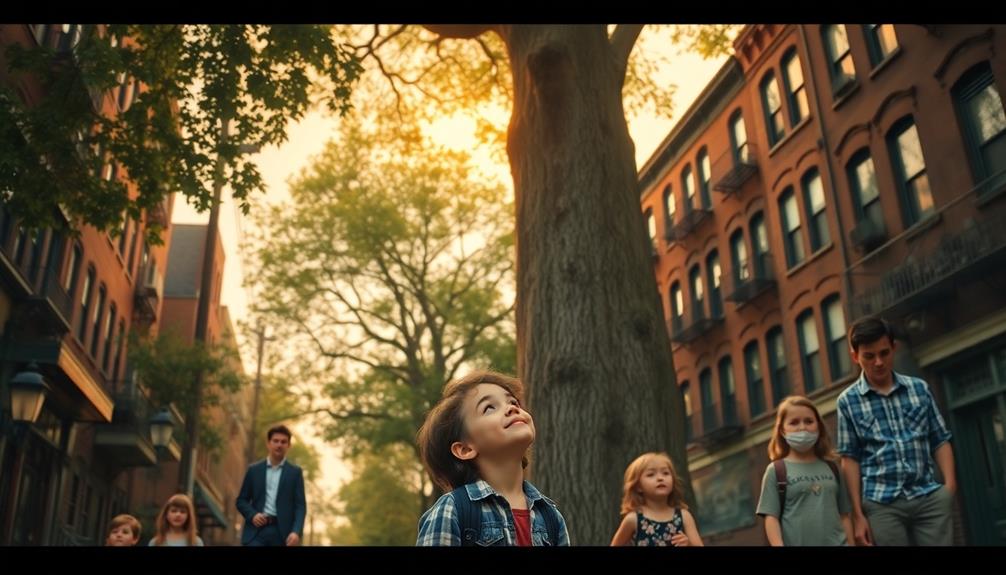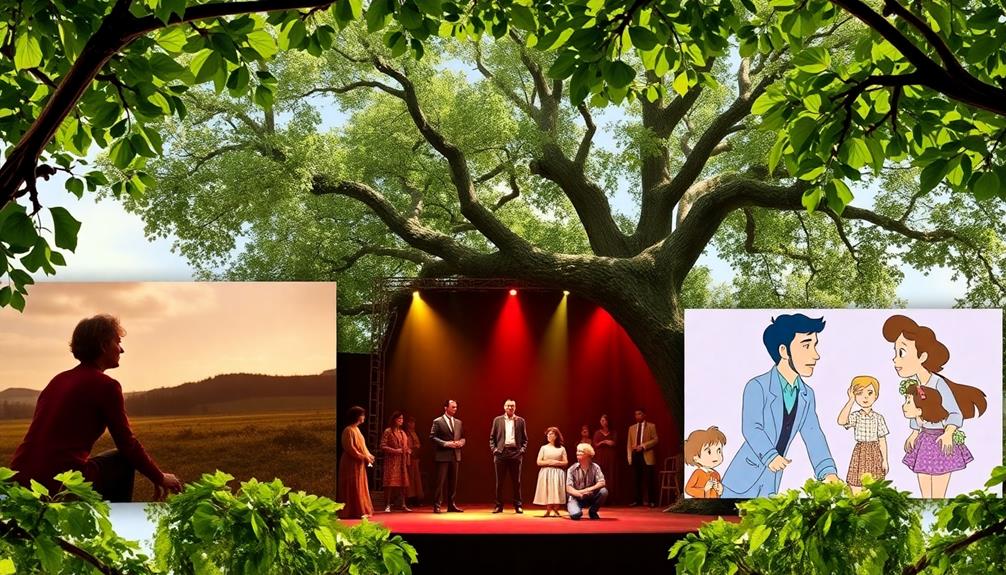Betty Smith, born to German immigrants in Brooklyn, poured her life experiences into *A Tree Grows in Brooklyn*. This semi-autobiographical novel showcases young Francie Nolan's struggles in a poverty-stricken neighborhood while embodying hope and resilience. Through hardship and family dynamics, Smith explores themes of determination, education, and the immigrant experience. Her writing reflects the challenges she faced, including her determination to rise above them. Smith's legacy lives on through this timeless work, resonating with readers around the world. If you explore further, you'll uncover the rich themes and symbols that make her story unforgettable.
Overview of the Novel
In *A Tree Grows in Brooklyn*, Betty Smith paints a vivid portrait of life in the early 20th century, focusing on the struggles and triumphs of young Francie Nolan. Growing up in the impoverished Williamsburg slums, Francie embodies resilience amid poverty, as she navigates the challenges faced by immigrant families in urban settings, particularly the harsh realities of generational poverty and resilience.
The novel, published in 1943, is semi-autobiographical, reflecting Smith's own experiences and the immigrant experience of many families during that era.
The narrative unfolds in five books, each illustrating distinct periods in the Nolan family's life, marked by challenges such as alcoholism and the quest for education. Central to Francie's journey is the Tree of Heaven, a powerful symbol of survival and hope. It represents her determination to rise above her circumstances and reach for her dreams, despite the societal constraints she faces.
Smith's exploration of education highlights its significance as a means of escape from poverty. *A Tree Grows in Brooklyn* is an American classic that resonates with readers, often used in educational settings to discuss social issues and the enduring human spirit.
Through Francie's eyes, you witness a poignant reflection of resilience that continues to inspire generations.
Betty Smith's Background
Betty Smith's life story is as compelling as the characters she created in her novels. Born Sophina Elisabeth Wehner on December 15, 1896, in Brooklyn, she was the daughter of German immigrants. This heritage deeply influenced her perspective on immigrant life and the struggles that come with it.
Her experiences resonate with themes of resilience similar to those found in Louis Zamperini's survival story during WWII, which showcases the strength of the human spirit in the face of adversity. Despite not completing high school, you'll find that her determination led her to enroll in university classes, where she won the prestigious Hopwood Award for her writing in 1930.
Her experiences with poverty and the complexities of family dynamics shaped her literary voice and served as the backbone of her semi-autobiographical work, *A Tree Grows in Brooklyn*. Working as a playwright and collaborating with the Federal Theatre Project, she honed her storytelling skills, allowing her to create rich, relatable characters.
This narrative of overcoming challenges reflects the overarching themes of hope and perseverance found in many historical narratives, such as those explored in Guns, Germs, and Steel.
In addition to her most famous novel, Smith published other notable works like *Tomorrow Will Be Better* (1947), *Maggie-Now* (1958), and *Joy in the Morning* (1963). Each piece reflects her journey and the resilience of the human spirit, further establishing her legacy in American literature.
Main Characters and Dynamics

In "A Tree Grows in Brooklyn," you see Francie Nolan's resilience as she navigates her challenging upbringing and dreams of becoming a writer.
Her journey mirrors the struggles faced by many during tough economic times, similar to the Joad family's plight in the Grapes of Wrath, highlighting themes of endurance and social injustice.
The struggles of her family, especially with alcohol's grip on her father, shape their relationships and lead to significant sacrifices.
Katie's determination to support her children after Johnny's death highlights the harsh realities they face, revealing the complex dynamics at play.
Francie's Resilience and Growth
Throughout "A Tree Grows in Brooklyn," Francie Nolan emerges as a symbol of hope and resilience, facing the harsh realities of her impoverished environment. Growing up in poverty, she grapples with her father Johnny's alcoholism and the weight of family dynamics that shape her aspirations. Despite these challenges, Francie's determination to pursue education becomes her lifeline.
Her relationship with her mother, Katie, highlights the tension between ambition and practicality. After Johnny's death, Katie assumes the role of the family breadwinner, often favoring her son, Neeley, which complicates Francie's sense of belonging. This favoritism fuels Francie's resilience as she seeks validation through her academic pursuits.
Support from friends like Ben Blake further nurtures Francie's growth, encouraging her to embrace her dreams despite the obstacles.
Through her journey, you witness how Francie's experiences with poverty, family dynamics, and the duality of her father's dreams shape her understanding of reality. Her resilience becomes a reflection of her character, as she learns to navigate the complexities of life while holding on to her aspirations, ultimately embodying the spirit of growth amidst adversity.
Family Struggles and Sacrifice
Amid the struggles of the Nolan family, the themes of sacrifice and resilience shine through the trials they face. Francie Nolan embodies hope amidst poverty, fueled by her father Johnny's dreams, even as his alcoholism casts a shadow over their lives.
When Johnny dies from pneumonia, Katie Nolan emerges as the family's backbone, showcasing remarkable resilience and hard work as the primary breadwinner. Her sacrifices highlight the shifting gender roles of the time, as she navigates the challenges of raising children alone.
The sibling relationship between Francie and her younger brother, Neeley, adds depth to their family struggles. While Katie often favors Neeley, the strain of parental stress complicates their bond, illustrating how adversity can impact relationships.
Sissy Rommely, Francie's illiterate aunt, further complicates their narrative, with her multiple marriages and adoption experiences reflecting the sacrifices made within the family unit.
Through these dynamics, Betty Smith paints a vivid picture of resilience in the face of hardship, reminding you that love and sacrifice often coexist within the complexities of family life.
Alcoholism's Impact on Relationships
Alcoholism profoundly alters the dynamics within the Nolan family, creating a rift that affects every relationship. Johnny Nolan's struggle with alcoholism leads to emotional distance between him and his loved ones. As his addiction deepens, the family's financial instability becomes evident, exacerbating their already dire situation in poverty.
Francie, caught between admiration for her father's dreams and the pain of his addiction, feels the weight of this complex bond.
Katie Nolan, Francie's mother, faces the challenge of becoming the primary breadwinner after Johnny's premature death from pneumonia. This shift in roles highlights the drastic changes in family responsibilities brought on by alcoholism.
The emotional distance that once defined the family now becomes even more pronounced as Katie navigates her new role, while Francie grapples with the loss of her father and the life they could have shared.
Ultimately, the impact of Johnny's alcoholism reverberates throughout their lives, leaving lasting scars on their relationships. It serves as a poignant reminder of how addiction can distort family dynamics and deepen the struggles faced by those living in poverty.
Themes of Resilience and Hope
Exploring the themes of resilience and hope in *A Tree Grows in Brooklyn* reveals the profound strength of its protagonist, Francie Nolan. You see, Francie embodies resilience as she navigates the struggles of her childhood in poverty-ridden Brooklyn. The titular Tree of Heaven symbolizes her tenacity, thriving against the harsh realities of life.
Through her unwavering hope for a better future, Francie dreams of education as a pathway out of her circumstances. Much like the stories shared by successful Australian women who've faced adversity, Francie's journey reflects a similar courage and determination to overcome challenges inspiring narratives of survival.
The narrative emphasizes her family's determination to find beauty amidst their struggles, showcasing how they celebrate small joys despite their socioeconomic challenges. Francie's experiences of hunger and hardship cultivate her creativity, illustrating the perseverance needed to overcome obstacles.
Her journey reflects the broader American dream, where hard work and resilience can lead to a brighter future. As you dive deeper into Francie's story, you can't help but feel inspired by her relentless spirit. Through her eyes, hope shines through, even when faced with adversity.
In *A Tree Grows in Brooklyn*, Betty Smith masterfully intertwines these themes, offering a poignant reminder of the strength found in resilience and the enduring power of hope.
Impact of Education

Education plays a pivotal role in *A Tree Grows in Brooklyn*, serving as the beacon of hope that guides Francie Nolan toward a brighter future. For Francie, education isn't just about learning; it's her ticket out of poverty. Influenced by her mother, Katie, and grandmother, Mary Rommely, she understands that knowledge is essential for breaking the cycle of hardship that has plagued her family for generations.
This mirrors the journey of characters like Pip in *Great Expectations*, who also seeks elevation through education and self-betterment, maneuvering the rigid class structures of his time the consequences of societal pressures.
Francie's commitment to her education shines through her daily habit of reading. Books become her refuge and a means to expand her horizons. Yet, pursuing education isn't easy. Balancing work and school, especially during the challenges of WWI, tests her resolve. She takes on jobs to support her family while working to keep up with her studies.
This struggle reflects the broader immigrant experience of early 20th-century America, where education symbolizes a path to upward mobility and personal empowerment. Through Francie's journey, you see how education transforms not just her life, but also the legacy of her family, illustrating the profound impact that knowledge can have in overcoming adversity.
Familial Relationships Explored
While steering through the challenges of poverty, the intricate familial relationships in *A Tree Grows in Brooklyn* greatly shape Francie Nolan's character and aspirations.
Francie's bond with her mother, Katie, is a constant push and pull between Katie's practicality and Francie's dreams of education. This dynamic mirrors the resilience and personal growth seen in characters from classic literature like Charles Dickens' *David Copperfield*, where love and sacrifice are central themes central themes of love. You can feel the tension as Katie embodies parental sacrifice, working tirelessly to support her family after Johnny's tragic death.
Johnny, with his affection and shared aspirations, offers Francie a glimpse of hope, though his struggles with alcoholism complicate their relationship and leave a void.
Francie's relationship with her younger brother, Neeley, showcases both loyalty and rivalry, reflecting the complexity of their shared experiences. Through their dynamic, you see how their struggles build their identities within the family unit.
Aunt Sissy Rommely, with her emotional depth and tumultuous relationships, stands in stark contrast to Katie's strictness, adding layers to the narrative. Her influence highlights the multifaceted struggles women face, shaping the family's fabric.
Adaptations Across Media

The rich tapestry of familial relationships in *A Tree Grows in Brooklyn* resonates deeply with audiences, leading to various adaptations that bring Francie Nolan's story to life across different media. The themes of personal growth and resilience, akin to those found in David Copperfield's journey, are effectively illustrated through these adaptations.
The 1945 film adaptation, directed by Elia Kazan, captured the essence of the novel and won critical acclaim, including an Academy Award for Best Supporting Actor for James Dunn. This film remains a beloved representation of the story.
In 1951, the narrative shifted to the stage with a Broadway musical produced by George Abbott, featuring music by Arthur Schwartz. Although it ran for 267 performances, it showcased the emotional depth of Francie's journey through song and dance.
Meanwhile, in 1944, a comic strip adaptation by William Meade Prince was distributed by King Features, which further popularized the tale and introduced it to a wider audience.
Additionally, a made-for-TV movie released in 1974 starred Cliff Robertson and Pamelyn Ferdin, bringing the story into homes across America. Each adaptation reflects the enduring cultural impact of *A Tree Grows in Brooklyn*, ensuring that Francie's story continues to inspire and resonate with new generations.
Cultural Significance and Legacy
As readers explore *A Tree Grows in Brooklyn*, they quickly realize its profound cultural significance and lasting legacy. Since its publication in 1943, the novel has sold over 4 million copies, showcasing its enduring popularity across generations. Its themes of resilience and the immigrant experience resonate deeply, making it a staple in educational curricula and discussions about American identity.
The narrative's exploration of resilience amidst adversity mirrors the struggles faced by characters in other significant literature, such as in the Holocaust and dangers of tyranny.
The book's cultural impact extends beyond the classroom; it served as significant literature during World War II, offering solace to military personnel through Armed Forces editions. This highlights how literature can provide comfort during challenging times, reinforcing the novel's role in shaping cultural conversations.
Notable figures like Oprah Winfrey have cited *A Tree Grows in Brooklyn* as a formative read, indicating its influence on personal development. Its ability to connect with diverse audiences is evident, as the novel has been translated into 16 languages, further solidifying its worldwide appeal.
In essence, Betty Smith's work not only captures the struggles and triumphs of its characters but also embodies a spirit of hope that continues to inspire readers today.
Symbolism in the Narrative

In "A Tree Grows in Brooklyn," the Tree of Heaven stands as a powerful symbol of resilience, mirroring the struggles and hopes of the Nolan family.
You'll see how Francie's love of books embodies her quest for knowledge and empowerment, showcasing education as an essential path out of poverty.
Together, these symbols reveal the heart of the narrative, illustrating the interplay between dreams and harsh realities.
Tree of Heaven
Many readers find the Tree of Heaven to be a striking symbol of resilience in Betty Smith's "A Tree Grows in Brooklyn." This unassuming Chinese sumac thrives in the harsh urban landscape, mirroring the struggles and aspirations of young Francie Nolan.
You see, the tree's ability to flourish through cracks in the concrete represents hope and determination, much like Francie's own journey through her impoverished upbringing.
As she navigates her challenges, the Tree of Heaven stands as a reflection of her perseverance. The Nolan family faces numerous hardships, yet the tree's resilience echoes their pursuit of the American dream. It's a powerful reminder that beauty and strength can emerge from difficult circumstances.
Throughout the novel, the tree symbolizes the human spirit, emphasizing the importance of nurturing one's potential. Just as the Tree of Heaven finds a way to grow in the unlikeliest of places, so too does Francie endeavor for growth against all odds.
This connection between Francie and the tree reinforces the theme of resilience, showcasing how life can flourish even in the most challenging environments. It's this interplay of hope and perseverance that truly captivates readers.
Education as Empowerment
Through the lens of education, Betty Smith crafts a powerful narrative in *A Tree Grows in Brooklyn* that underscores the importance of learning as a means of empowerment for Francie Nolan. In a world marked by poverty, Francie's determination to seek education becomes her lifeline. Nurtured by her mother, Katie, and her grandmother, Mary Rommely, she learns that knowledge is key to breaking the cycle of hardship and achieving upward mobility.
Francie's love for reading symbolizes her quest for knowledge and a brighter future. By committing to read a book every day, she not only escapes her harsh reality but also builds resilience against life's challenges. Each page she turns equips her with the tools necessary to confront her circumstances, reinforcing the transformative power of education.
Smith's narrative critiques societal barriers, illustrating how access to education can empower working-class families. For Francie, education isn't just about academic success; it's a pathway to self-discovery and hope.
In embracing learning, she rises above her struggles, embodying the belief that through education, one can truly find empowerment and a way out of poverty.
Reception and Awards
Upon its release, *A Tree Grows in Brooklyn* captured the attention of readers and critics alike, quickly selling nearly 3 million copies within two years. This overwhelming success granted Betty Smith unprecedented income and solidified her place in literary circles.
The novel received critical acclaim for its poignant exploration of the immigrant experience and social issues, touching on themes that remain culturally relevant today.
Translated into 16 languages, *A Tree Grows in Brooklyn* has stayed in print since 1943, with over 4 million copies sold to date, reflecting its enduring appeal.
In 1945, the story was adapted into a successful film directed by Elia Kazan, which garnered an Academy Award for Best Supporting Actor for James Dunn and a Special Academy Award for Peggy Ann Garner as Outstanding Child Actress.
Despite some initial critiques labeling the book as sentimental, it has grown in recognition, particularly among those who appreciate its depth and insight.
Notable figures like Oprah Winfrey have praised Smith's work, underscoring its lasting influence across generations and its powerful commentary on the human experience.
Conclusion
Betty Smith's "A Tree Grows in Brooklyn" still resonates today, reminding you of the strength found in resilience and hope. As you navigate life's challenges—like scrolling through social media—you can find inspiration in Francie's journey. Her story illustrates the importance of education and the pursuit of dreams, showing that, even in tough times, growth is possible. Smith's legacy lives on, encouraging you to embrace your roots while reaching for the stars.



